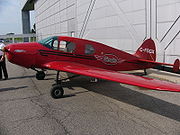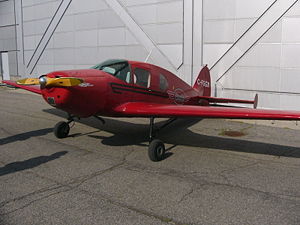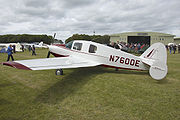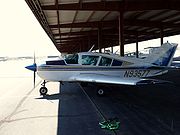
Bellanca Cruisair
Encyclopedia
The Bellanca 14-7 Cruisair and its successors were a family of single-engined light aircraft manufactured in the United States
from the mid 1930s onwards.
monoplane with a fuselage
intended to contribute lift to the design. Although the prototype flew with fixed tailwheel undercarriage
, the 14-9 production version was the first US light aircraft to be mass-produced with retractable undercarriage, the main wheels rotating aft into wheel-wells in the wings, with approximately 50 produced before production was interrupted by World War II
.
 After WWII Bellanca resumed production with the up-dated Bellanca 14-13 Cruisair Senior, retaining the Bellanca 14-7's basic design, featuring an enlarged cabin, a horizontally opposed
After WWII Bellanca resumed production with the up-dated Bellanca 14-13 Cruisair Senior, retaining the Bellanca 14-7's basic design, featuring an enlarged cabin, a horizontally opposed
Franklin 6A4-335-B3 150 hp engine in place of the earlier models' Le Blond radial
and an oval vertical endplate on each horizontal stabiliser
. This latter feature gained the type the affectionate nickname "Cardboard Constellation", because the arrangement is similar to the contemporary Lockheed Constellation
airliner.
The naming convention for Bellanca aircraft was followed with the Cruisair series, with the first number giving the wing area in square feet, (dropping the final digit), while the second number is the aircraft's horsepower, (again dropping the final digit).
Construction of the series is fairly conventional with wings constructed of Spruce with plywood skin and fuselage
s built up from a welded steel-tube framework with a fabric covering.
A constant process of refinement led to many variants, sometimes given new names but retaining the same structure differing only in powerplant, minor details and furnishings. The only major variations were the introduction of a single swept fin and tri-cycle retractable undercarrriage. Production was carried out at a variety of companies;Bellanca, Downer
, Aviabellanca, Northern
and Inter-Air with little variation other than powerplant and furnishings.
The highly responsive flying characteristics of the aircraft are evident to anyone who has flown one. Bill Cox, the well known aviation journalist at Plane and Pilot Magazine commented regarding the flying qualities of Vikings that they "have long been famous for control response and harmony that seems almost psychic in nature" , and asserted, "Owners almost unanimously pronounce the Viking the best handling airplane they've ever flown."
Pre-war development culminated in the 1941 14-12, at which point production ceased to allow Bellanca to work as a military subcontractor for the duration of the war when an attempt to market a militarized version as a trainer was unsuccessful. After the war, Bellanca returned to the design to create the Bellanca 14-13
and its successors.


and granted FAA approval on January 7, 1957 as the 14-19-2 Cruisemaster. The new model featured a 230 hp Continental O-470K
engine, an increased gross weight of 2,700 pounds, an updated instrument panel as well as new paint and upholstery schemes. 104 of these airplanes were produced between 1957 and 1958
The company was renamed Downer Aircraft
in 1959. Inter-Air
acquired the production rights in 1962 and was renamed as the Bellanca Sales Company
, a subsidiary of Miller Flying Service. Further development of the design by Inter-Air resulted in the modernized Viking
series introduced in 1962.

based company employed skilled craftsman who manufactured the wing from spruce and the new 300 hp model was named the "Viking" in respect to the many Scandinavians of the area.
The first Model 17 Viking appeared in 1967 called the "17-30" it was powered by a 300 hp Continental IO-520-K
. In 1969 a Viking powered by a 290 hp (later 300 hp) Lycoming IO-540
was introduced, either normally aspirated (17-31) or turbocharged (17-31TC).
 Over the years there were a number of refinements in the aircraft. The original hydraulic gear and flap actuation system was redesigned in 1968 introducing electric flaps. In 1969 the FAA issued Type Certificate A18CE and the aircraft built under that design were designated the "A" series "Super Vikings". Aside from refinements already made to late Viking 300 models, the new 300A Vikings (17-30A, 17-31A and 17-31ATC) had a gross weight increase to 3,325 lbs.The original complex fuel system with five tanks and two fuel selectors allowing eight possible combinations of selector settings was simplified to a left, right and auxiliary system in 1974. In 1979 the Continental powered Vikings sported a fully enclosed nosewheel thanks to a redesign of the engine mount. This necessitated the use of cowl flaps for the first time on the Viking but resulted in a 12 mph increase. In 1979 production of the Lycoming powered 17-31A ceased. In 1996, the Lycoming IO-550 was made available as an option.
Over the years there were a number of refinements in the aircraft. The original hydraulic gear and flap actuation system was redesigned in 1968 introducing electric flaps. In 1969 the FAA issued Type Certificate A18CE and the aircraft built under that design were designated the "A" series "Super Vikings". Aside from refinements already made to late Viking 300 models, the new 300A Vikings (17-30A, 17-31A and 17-31ATC) had a gross weight increase to 3,325 lbs.The original complex fuel system with five tanks and two fuel selectors allowing eight possible combinations of selector settings was simplified to a left, right and auxiliary system in 1974. In 1979 the Continental powered Vikings sported a fully enclosed nosewheel thanks to a redesign of the engine mount. This necessitated the use of cowl flaps for the first time on the Viking but resulted in a 12 mph increase. In 1979 production of the Lycoming powered 17-31A ceased. In 1996, the Lycoming IO-550 was made available as an option.

configuration and wood and fabric construction that harkened back to an earlier age. Postwar economics along with a glut of surplus military aircraft precluded heavy sales although about 600 were produced.
Despite its introduction into a period where private aircraft sales were stagnant, the aircraft remained popular through all of its incarnations and today is considered a classic cabin monoplane and is much in demand.
Since 2002 the company has been operated by a group of six Bellanca enthusiasts who bought the company from the state of Minnesota and established Alexandria Aircraft Co. LLC, providing technical support and parts for owners and maintenance organisations in the field. New aircraft have been available from Alexandria Aircraft Co., who have sold one new aircraft manufactured in 2005.
14-9
14-10L - fitted with a 100 hp (75 kW) Lycoming
engine.
14-12 - with Franklin 6AC
engine
14-13
T14-14
14-19
Downer 260
Miller 260A
Aviabellanca 260C
17-30 Viking 300
United States
The United States of America is a federal constitutional republic comprising fifty states and a federal district...
from the mid 1930s onwards.
Design and development
Bellanca established itself in the market for 6-8 seat aircraft, but believed that it could also successfully sell smaller 3-4 seat aircraft. To fill this niche Bellanca designed The '14-7 Cruisair' as a modern, low-wing cantileverCantilever
A cantilever is a beam anchored at only one end. The beam carries the load to the support where it is resisted by moment and shear stress. Cantilever construction allows for overhanging structures without external bracing. Cantilevers can also be constructed with trusses or slabs.This is in...
monoplane with a fuselage
Fuselage
The fuselage is an aircraft's main body section that holds crew and passengers or cargo. In single-engine aircraft it will usually contain an engine, although in some amphibious aircraft the single engine is mounted on a pylon attached to the fuselage which in turn is used as a floating hull...
intended to contribute lift to the design. Although the prototype flew with fixed tailwheel undercarriage
Conventional landing gear
thumb|The [[Piper PA-18|Piper Super Cub]] is a popular taildragger aircraft.thumb|right|A [[Cessna 150]] converted to taildragger configuration by installation of an after-market modification kit....
, the 14-9 production version was the first US light aircraft to be mass-produced with retractable undercarriage, the main wheels rotating aft into wheel-wells in the wings, with approximately 50 produced before production was interrupted by World War II
World War II
World War II, or the Second World War , was a global conflict lasting from 1939 to 1945, involving most of the world's nations—including all of the great powers—eventually forming two opposing military alliances: the Allies and the Axis...
.

Flat-4
A flat-4 or horizontally opposed-4 is a flat engine with four cylinders arranged horizontally in two banks of two cylinders on each side of a central crankcase...
Franklin 6A4-335-B3 150 hp engine in place of the earlier models' Le Blond radial
Radial engine
The radial engine is a reciprocating type internal combustion engine configuration in which the cylinders point outward from a central crankshaft like the spokes on a wheel...
and an oval vertical endplate on each horizontal stabiliser
Tailplane
A tailplane, also known as horizontal stabilizer , is a small lifting surface located on the tail behind the main lifting surfaces of a fixed-wing aircraft as well as other non-fixed wing aircraft such as helicopters and gyroplanes...
. This latter feature gained the type the affectionate nickname "Cardboard Constellation", because the arrangement is similar to the contemporary Lockheed Constellation
Lockheed Constellation
The Lockheed Constellation was a propeller-driven airliner powered by four 18-cylinder radial Wright R-3350 engines. It was built by Lockheed between 1943 and 1958 at its Burbank, California, USA, facility. A total of 856 aircraft were produced in numerous models, all distinguished by a...
airliner.
The naming convention for Bellanca aircraft was followed with the Cruisair series, with the first number giving the wing area in square feet, (dropping the final digit), while the second number is the aircraft's horsepower, (again dropping the final digit).
Construction of the series is fairly conventional with wings constructed of Spruce with plywood skin and fuselage
Fuselage
The fuselage is an aircraft's main body section that holds crew and passengers or cargo. In single-engine aircraft it will usually contain an engine, although in some amphibious aircraft the single engine is mounted on a pylon attached to the fuselage which in turn is used as a floating hull...
s built up from a welded steel-tube framework with a fabric covering.
A constant process of refinement led to many variants, sometimes given new names but retaining the same structure differing only in powerplant, minor details and furnishings. The only major variations were the introduction of a single swept fin and tri-cycle retractable undercarrriage. Production was carried out at a variety of companies;Bellanca, Downer
Downer
Downer may refer to:* Downer , various persons of that name* Downer, Australian Capital Territory, a suburb of Canberra, Australia* Downer Glacier, Alaska* Downer, Minnesota, an unincorporated community* Downer , the New Jersey state soil...
, Aviabellanca, Northern
Northern
-Geography:* Northern , various regions, states, territories, etc.* Northern Range, a range of hills in Trinidad* Northern Highland, a region of Wisconsin, United States-Education:* Northern University , various institutions...
and Inter-Air with little variation other than powerplant and furnishings.
The highly responsive flying characteristics of the aircraft are evident to anyone who has flown one. Bill Cox, the well known aviation journalist at Plane and Pilot Magazine commented regarding the flying qualities of Vikings that they "have long been famous for control response and harmony that seems almost psychic in nature" , and asserted, "Owners almost unanimously pronounce the Viking the best handling airplane they've ever flown."
Pre-war development culminated in the 1941 14-12, at which point production ceased to allow Bellanca to work as a military subcontractor for the duration of the war when an attempt to market a militarized version as a trainer was unsuccessful. After the war, Bellanca returned to the design to create the Bellanca 14-13
Bellanca 14-13
|-See also:-References:NotesBibliography* Davisson, Budd. "We Fly the Cardboard Constellation" Air Progress Vintage Buyer's Guide, 1989.* Mondey, David. The Complete Illustrated Encyclopedia of the World's Aircraft. Secaucus, NJ: Chartwell Books Inc, 1978. ISBN 0-89009-771-2.* Palmer, Trisha, ed....
and its successors.

Model 14-13
The 14-13 was introduced in 1946; in its improved 14-13-3 version the aircraft remained in production until 1956.Model 14-19
A higher performance design revision was granted FAA approval as the 14-19 Cruisemaster on September 26, 1949,. The new model featured structural upgrades, a 190 hp Lycoming O435-A engine, an increased gross weight of 2,600 lbs, hydraulically operated landing gear and flaps, and a deluxe interior. 99 of these airplanes were produced between 1949 and 1951. Externally, a near-look-alike to the earlier models, this version was distinguished by its larger, oval-shaped endplates. All production ceased in 1956 as Bellanca wound up its operations.
Model 14-19-2
The 14-19 design was revived by Northern AircraftAviaBellanca Aircraft
AviaBellanca Aircraft Corporation is an American aircraft design and manufacturing company. Prior to 1983 it was known as the Bellanca Aircraft Company...
and granted FAA approval on January 7, 1957 as the 14-19-2 Cruisemaster. The new model featured a 230 hp Continental O-470K
Continental O-470
The Continental O-470 engine is a family of carbureted six-cylinder, horizontally opposed, air-cooled aircraft engines that was developed especially for use in light aircraft by Continental Motors. The family includes the E165, E185 and the E225 engines...
engine, an increased gross weight of 2,700 pounds, an updated instrument panel as well as new paint and upholstery schemes. 104 of these airplanes were produced between 1957 and 1958
The company was renamed Downer Aircraft
AviaBellanca Aircraft
AviaBellanca Aircraft Corporation is an American aircraft design and manufacturing company. Prior to 1983 it was known as the Bellanca Aircraft Company...
in 1959. Inter-Air
AviaBellanca Aircraft
AviaBellanca Aircraft Corporation is an American aircraft design and manufacturing company. Prior to 1983 it was known as the Bellanca Aircraft Company...
acquired the production rights in 1962 and was renamed as the Bellanca Sales Company
AviaBellanca Aircraft
AviaBellanca Aircraft Corporation is an American aircraft design and manufacturing company. Prior to 1983 it was known as the Bellanca Aircraft Company...
, a subsidiary of Miller Flying Service. Further development of the design by Inter-Air resulted in the modernized Viking
Bellanca 17-30
-External links:* * * * * *...
series introduced in 1962.

Bellanca Viking
The Bellanca Viking and Super Viking were developed through modifications of the 'Cruisair' designs by the aviation pioneer Giuseppe Bellanca. Derived directly from the Cruisair, the Viking introduced a swept single tail of similar area, replacing the triple-tail of earlier aircraft, initially manufactured by Downer Aircraft as the Model 260 starting around 1958. The Viking model was born out of discussions at Downer for a bigger version of the "Model 260" with at least 300 horsepower. The MinnesotaMinnesota
Minnesota is a U.S. state located in the Midwestern United States. The twelfth largest state of the U.S., it is the twenty-first most populous, with 5.3 million residents. Minnesota was carved out of the eastern half of the Minnesota Territory and admitted to the Union as the thirty-second state...
based company employed skilled craftsman who manufactured the wing from spruce and the new 300 hp model was named the "Viking" in respect to the many Scandinavians of the area.
The first Model 17 Viking appeared in 1967 called the "17-30" it was powered by a 300 hp Continental IO-520-K
Continental O-520
-External links:...
. In 1969 a Viking powered by a 290 hp (later 300 hp) Lycoming IO-540
Lycoming O-540
|-Specifications :-See also:-External links:...
was introduced, either normally aspirated (17-31) or turbocharged (17-31TC).


Operational history
Designed and produced in the post-World War II era, the Bellanca 14-13 Cruisair Senior was aimed at a general aviation market. Pilot/owners were offered a combination of performance, low engine power and a modest price of $4500. Its performance and structural strength also made it attractive for utility work, but in many ways the Bellanca design was an anachronism, relying on a conventional landing gearConventional landing gear
thumb|The [[Piper PA-18|Piper Super Cub]] is a popular taildragger aircraft.thumb|right|A [[Cessna 150]] converted to taildragger configuration by installation of an after-market modification kit....
configuration and wood and fabric construction that harkened back to an earlier age. Postwar economics along with a glut of surplus military aircraft precluded heavy sales although about 600 were produced.
Despite its introduction into a period where private aircraft sales were stagnant, the aircraft remained popular through all of its incarnations and today is considered a classic cabin monoplane and is much in demand.
Since 2002 the company has been operated by a group of six Bellanca enthusiasts who bought the company from the state of Minnesota and established Alexandria Aircraft Co. LLC, providing technical support and parts for owners and maintenance organisations in the field. New aircraft have been available from Alexandria Aircraft Co., who have sold one new aircraft manufactured in 2005.
Variants
Junior 14-7- Prototype with fixed undercarriage and LeBlond 5E radial piston engine.
- 14-7L - 14-7 with Lenape LM-5 engine.
14-9
- Main production version with retractable undercarriage and Ken-Royce 5F radial piston engine.
- 14-9L - Fitted with a Lenape Brave engine.
14-10L - fitted with a 100 hp (75 kW) Lycoming
Lycoming Engines
Lycoming Engines is a U.S. aircraft engine company, known primarily for its general aviation engines. For most of its history Lycoming has been part of the AVCO group as AVCO Lycoming. In 1987 AVCO was purchased by Textron to become Textron Lycoming...
engine.
14-12 - with Franklin 6AC
Franklin Engine Company
The Franklin Engine Company was a manufacturer of aircraft engines, formed as the H. H. Franklin Co. in 1902, located in Syracuse, New York, United States. Barely surviving bankruptcy in 1933, the company was purchased by a group of ex-employees and renamed Aircooled Motors in 1937...
engine
14-13
- Initial model introduced in 1946
- 14-13-2 - Improved model introduced in 1947. Featured a longer span stabilizer with smaller endplates and an external baggage door.
- 14-13-3 - Improved model introduced in 1948, which remained in production until 1956
- 14-13W - Wagon version with plywoodPlywoodPlywood is a type of manufactured timber made from thin sheets of wood veneer. It is one of the most widely used wood products. It is flexible, inexpensive, workable, re-usable, and can usually be locally manufactured...
-lined cabin and removable rear seats
T14-14
- Militarized trainer version (single prototype only).
14-19
- 190 hp version introduced in 1949
- 14-19-2 - 230 hp version introduced in 1957
- 14-19-3 - 260 hp tricycle gearTricycle gearTricycle gear describes an aircraft undercarriage, or landing gear, arranged in a tricycle fashion. The tricycle arrangement has one wheel in the front, called the nose wheel, and two or more main wheels slightly aft of the center of gravity...
version introduced in 1959 by Downer Aircraft
Downer 260
- 14-19-3 production by Downer Aircraft Industries Inc.
Miller 260A
- Further production of the 14-19 by Miller Flying Service, which had acquired the rights for manufacture from International Aircraft Mfg Inc. (Inter-Air)
Aviabellanca 260C
- Model 14-19-3C version built in the late 1960s by Inter-AirAviaBellanca AircraftAviaBellanca Aircraft Corporation is an American aircraft design and manufacturing company. Prior to 1983 it was known as the Bellanca Aircraft Company...
with revised empennage and 260 hp (194 kW) Continental IO-470-F engine
17-30 Viking 300
- Four-seat light cabin aircraft, powered by a 224-kW (300-hp) Continental IO-520-K piston engine.
- 17-30A Super Viking 300A: Four-seat light cabin aircraft, powered by a 224-kW (300-hp) Continental IO-520-K piston engine.
- 17-31 Viking 300': Four-seat light cabin aircraft, powered by a 224-kW (300-hp) Lycoming IO-540 piston engine.
- 17-31A Super Viking 300A: Four-seat light cabin aircraft, powered by a 224-kW (300-hp) Lycoming IO-540-K1ES piston engine.
- 17-31ATC Super Viking 300A: Four-seat light cabin aircraft, powered by a 224-kW (300-hp) Lycoming IO-540-K1ES piston engine, the aircraft is fitted with two Rajay turbochargers.
- 17-31TC Viking 300: Four-seat light cabin aircraft, powered by a 224-kW (300-hp) Lycoming IO-540 piston engine, the aircraft is fitted with turbocharger.

